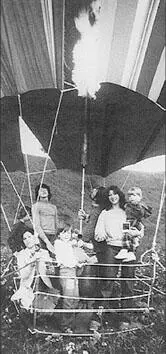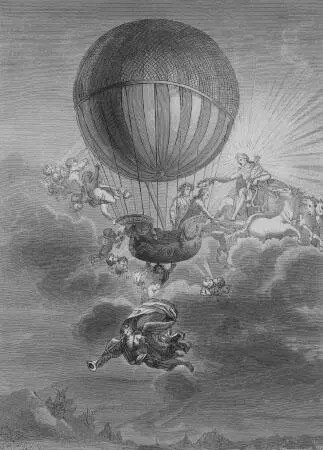At this desperate moment, the two families joined forces again. Working around the clock, the Strelzyks and the Weltzers constructed a much bigger balloon using piecemeal sections of artificial taffetas and dress materials, hastily purchased from small shops all over East Germany. An electric engine was attached to the sewing machine, and the propane burner was redesigned. In a matter of six weeks they had a new balloon looking like a huge multicoloured quilt. When fully inflated it stood nearly ninety feet high, and had a hot-air capacity of over 140,000 cubic feet, double that of the previous balloon. Its burner was powered by four propane tanks feeding into a simple five-inch-diameter stovepipe, capable of producing a narrow, violent flame which at maximum pressure shot fifty feet into the air – within thirty feet of the inner crown of the balloon. This could in theory lift well over 1,200 pounds (544 kilograms), the equivalent of seven adults and a child plus all the balloon equipment. But everything depended on the durability of the home-made envelope, the strength and direction of the wind, and the general flying conditions (including air temperature and humidity) on the actual night of the flight.
Unable to obtain materials for a conventional wicker basket, they constructed instead an open metal platform four and a half feet square. The four propane cylinders stood in the centre of this platform, and the eight passengers carefully distributed their weight around them, having to crouch within inches of the platform’s outer edge. The youngest Wetzel was held in his mother’s arms. The ten guy ropes connected to the balloon were tethered to iron stanchions welded along the edges of the platform, which provided some handholds. There was also an outer guardrail made of loops of washing line, but this only came up to the adults’ waists. The stovepipe burner was ignited by a household match, and at full power burnt with a tremendous roar about six feet above the passengers’ heads, shooting flame high into the centre of the balloon. When this ‘flame-thrower’ was extinguished, they would float in absolute darkness and silence, standing virtually unprotected in the air, with no sound but the creak of the ropes against the balloon fabric, somewhere invisible above their heads. It was a magnificent, dreamlike, insane contraption. But it flew.
At 2 a.m. on the night of 16 September 1979, with a brisk eighteen-mile-per-hour breeze blowing towards West Germany, they took off from their secret base in the Thuringian forest, about six miles from the frontier. They cleared the fir trees, and with a tremendous blast from the propane burner, the balloon rose rapidly to 6,500 feet. But as it turned on its axis in the dark, they soon lost all sense of direction. Clinging together on the tiny metal platform, they peered down in silence, looking for car headlamps which would indicate roads, or the chain of lights which would mark the border.
After about twenty minutes, to their alarm, they suddenly saw searchlights springing up almost directly beneath them. They had the choice to drift downwards, steadily sinking but hoping to avoid detection in the dark, or to fire up their burner and try to climb clear. They chose to fire the burner, and with a huge sustained burst of flame, which they felt must surely be visible for miles around, rose to nearly nine thousand feet. Under either the increased heat or the air pressure, the crown of the balloon split. They began to sink again, but the balloon remained inflated, and by continuing to fire the burner until their propane ran out, they managed a crash-landing in an open field a hundred yards from a high-voltage pylon. Günter Wetzel broke his leg, but otherwise they were all unhurt, although they had no idea on which side of the border they had arrived. Peter Strelzyk walked over and shone a torch on the ‘Danger of Death’ sign fixed to the base of the pylon. It belonged to a West German electricity company. They had flown to freedom – and to fame – in exactly twenty-eight minutes. ‘We could have made it as far as Bayreuth,’ remarked Wetzel. 10 fn4

The theme of escape, either literally from some form of imprisonment, or symbolically from the troubles of the earth itself, constantly recurs in the history of ballooning. When Dr Alexander Charles made the first ever flight by a true hydrogen balloon, two hundred years before the escape of the Strelzyks and the Wetzels, on 1 December 1783, it was the feeling of absolute and almost metaphysical freedom that overcame him.
Flying with an engineering assistant, Monsieur Robert, Dr Charles launched from the Jardin des Tuileries in central Paris, and travelled over twenty miles north-west to the country town of Nesles. His balloon was a mere thirty feet high, but was equipped with a proper wicker basket, a venting valve, and sacks of ballast to adjust its height and control its descent. His departure was witnessed by nearly half a million people, among them the American ambassador, Benjamin Franklin. After they had landed safely at Nesles, Monsieur Robert disembarked, but Dr Charles remained in the basket. He then achieved the first ever solo ascent, rapidly rising in the lightened balloon to a magnificent ten thousand feet. From this vantage point he saw the sun set for a second time on the same day. It was a revelation.
Dr Charles’s brilliant account of this ascent was widely published in both Britain and France, and catches a euphoric tone which never quite disappears from subsequent balloon accounts. He had laid in supplies for an aerial journey of many hours – fur coats, cold chicken and champagne. But what he actually tasted was that existential substance:
Nothing will ever quite equal that moment of total hilarity that filled my whole body at the moment of take-off. I felt we were flying away from the Earth and all its troubles and persecutions for ever. It was not mere delight. It was a sort of physical rapture … I exclaimed to my companion Monsieur Robert – ‘I’m finished with the Earth. From now on our place is in the sky! … Such utter calm. Such immensity! Such an astonishing view … Seeing all these wonders, what fool could wish to hold back the progress of science!’ 12

Benjamin Franklin watched the launch through a telescope from the window of his carriage. Afterwards he remarked, ‘Someone asked me – what’s the use of a balloon? I replied – what’s the use of a new-born baby. ’
The same sense of escaping into an utterly new world is displayed by Thomas Baldwin’s Airopaedia, or Narrative of a Balloon Excursion from Chester in 1785 . This is his account of a single flight made on 8 September 1785, flying northwards above the river Mersey, from Chester to Warrington in Lancashire. It must be one of the most remarkable books about the experience of ballooning ever written. It also included flight maps, and the first aerial drawings ever made from a balloon basket.
Baldwin was one early pioneer of the existential attitude to ballooning, in which the idea that the ‘Prospect’ itself – the free ascent, the magnificent views, the whole ‘aerial experience’ – was the real point of flight. He believed that ‘previous Balloon-Voyagers have been particularly defective in their Descriptions of aerial Scenes and Prospects’. Consequently he took with him a battery of recording equipment: a variety of pens and red lead pencils, special ‘Ass Skin Patent Pocketbooks’, paints and brushes, drawing blocks and perspective glasses, telescopes and compasses. Airopaedia contained the first ever paintings of the view from a balloon basket, an analytic diagram of the corkscrew flight path projected over a land map, and a whole chapter given up simply to describing the astonishing colours and structures of cloud formations.
Читать дальше














